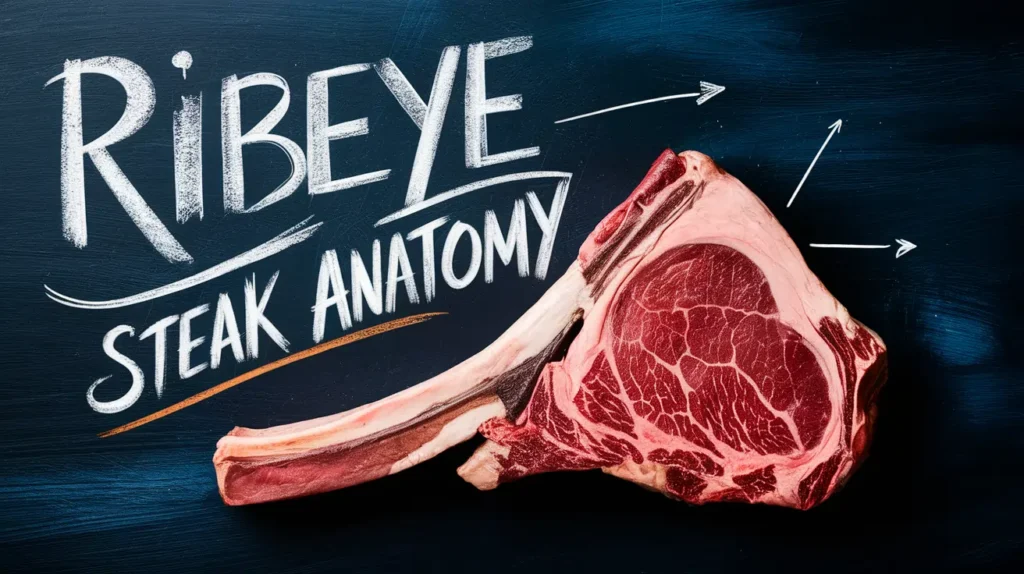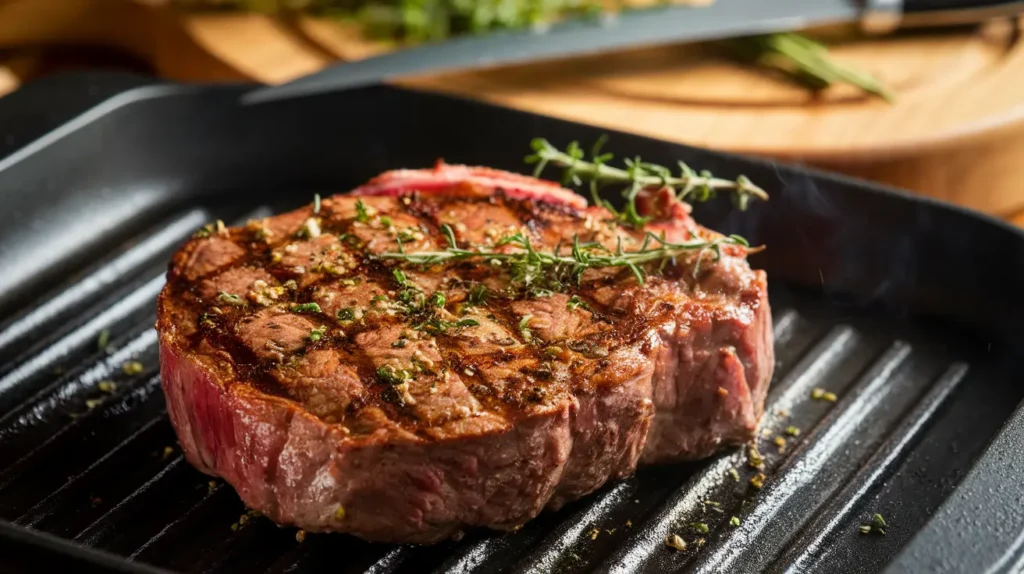Introduction to Rib Cap and Spinalis
Is Rib Cap the Same as Spinalis? Ever wonder if rib cap and spinalis are the same thing? 🤔 Don’t worry—you’re not alone. These two terms often pop up in conversations among foodies and chefs, leaving many scratching their heads. Are they just fancy names for the same cut of beef? Or are they completely different? Let’s dig in and find out!
Table of Contents
What is Rib Cap?

Let’s start with the rib cap. Imagine the most tender and flavorful part of a steak—that’s your rib cap. 🥩 It’s the outer layer of the ribeye, known for its buttery texture and incredible marbling. When cooked, it practically melts in your mouth, making it a favorite among steak lovers. It’s often referred to as the “chef’s cut” because it’s so prized for its rich flavor.
“The rib cap is like the icing on the steak cake—rich, indulgent, and unforgettable!”
What is Spinalis?
Now, let’s talk about spinalis. The spinalis dorsi, often called the ribeye cap, is actually part of the rib cap. Confused? Don’t be! Think of it as a sub-section of the rib cap, located on the outer edge of the ribeye muscle. Its marbling and flavor make it a steakhouse superstar. Many argue it’s the best part of the ribeye, and it’s hard to disagree! 🌟
Why the Confusion Between Rib Cap and Spinalis?
The confusion comes down to terminology. Some people use “rib cap” and “spinalis” interchangeably, while others treat them as separate entities. In reality, the spinalis is part of the rib cap. It’s like how all squares are rectangles, but not all rectangles are squares. Clear as mud? Let’s break it down further!
The Anatomy of Rib Cap and Spinalis
To truly understand these cuts, let’s take a closer look at their anatomy. Knowing where they come from on the cow will help you see why they’re so special.
Rib Cap: Location and Characteristics
The rib cap sits on top of the ribeye, wrapping around the steak like a luxurious blanket. It’s the layer that gives ribeye its signature richness. With its high fat content and perfect marbling, the rib cap is all about indulgence. When grilled or seared, it develops a crispy, flavorful crust while staying juicy inside. 😋
Spinalis: Location and Characteristics
The spinalis is the crown jewel of the rib cap. It’s the thin, crescent-shaped muscle that lies along the outer edge of the ribeye. While it shares the rib cap’s tenderness and marbling, the spinalis has an even finer texture and more concentrated flavor. It’s like the VIP section of the steak world! 💎
How They Relate to Each Other in Beef Cuts
To sum it up, the spinalis is a specific muscle within the rib cap. If the rib cap were a chocolate cake, the spinalis would be the decadent ganache layer—small but oh-so-important. Knowing this distinction makes it easier to understand why people rave about these cuts!
Culinary Uses of Rib Cap and Spinalis
Now that we’ve covered the basics, let’s dive into the kitchen. How do you cook these cuts? What are the best recipes? Let’s explore! 🧑🍳
Cooking Methods for Rib Cap
Rib cap is incredibly versatile. You can grill it, sear it, or even roast it. The key is to let its natural fat work its magic. A simple seasoning of salt, pepper, and garlic is all you need to let its flavor shine. Want to take it up a notch? Try basting it with butter and herbs for that restaurant-quality touch. 🌿🧈
Cooking Methods for Spinalis
Cooking spinalis is like handling a precious gem—less is more. Its delicate texture means it cooks quickly, so keep an eye on it. High heat and short cooking times are your best friends. Think cast iron skillet with a quick sear. Serve it medium-rare to preserve its buttery goodness. 😍
Best Recipes Featuring Rib Cap
| Recipe | Ingredients | Cooking Time |
|---|---|---|
| Grilled Rib Cap Steak | Rib cap, salt, pepper, olive oil, rosemary | 15 minutes |
| Herb-Crusted Rib Cap | Rib cap, garlic, parsley, thyme, butter | 20 minutes |
Best Recipes Featuring Spinalis
Looking to highlight spinalis? Keep it simple. A light seasoning and a quick sear are all you need. Pair it with a chimichurri sauce or a red wine reduction for an elegant touch. Want to impress your guests? Serve it with truffle mashed potatoes and grilled asparagus. 🍷✨
Flavor and Texture: How Do They Compare?
When it comes to steak, flavor and texture are everything. But how do rib cap and spinalis stack up against each other? Let’s compare these two heavyweights of the beef world. 🥊
Flavor Profile of Rib Cap
The rib cap is a flavor bomb. Thanks to its high fat content and exceptional marbling, every bite is rich, juicy, and satisfying. Think of it as the steak equivalent of your favorite comfort food. It has that hearty, beefy flavor that makes steak lovers swoon. Add a perfect sear, and you’ve got yourself a slice of heaven. 🌟
Flavor Profile of Spinalis
The spinalis, on the other hand, is all about finesse. Its flavor is slightly more concentrated, offering a buttery, melt-in-your-mouth experience. If the rib cap is a bold red wine, the spinalis is a silky champagne—both amazing, but with distinct vibes. Its texture is also finer, making it a favorite for those who love tender, delicate cuts. 🥂
Common Questions and Misconceptions
Let’s clear the air on some common myths and questions about rib cap and spinalis. After all, knowledge is the secret ingredient to mastering these cuts! 🧠
Are Rib Cap and Spinalis the Same Cut?
Not exactly! While the spinalis is part of the rib cap, they’re not interchangeable terms. The rib cap includes the outer layer of the ribeye, while the spinalis is a specific muscle within that layer. Think of it like a family tree—the spinalis is a member of the rib cap family.
Can You Substitute One for the Other?
Yes and no. If your recipe calls for rib cap, you can use spinalis since it’s a component of the rib cap. But remember, spinalis is smaller and more tender, so adjust your cooking time accordingly. For dishes requiring larger portions, rib cap might be the better choice.
Why Are They So Popular Among Steak Lovers?
Simple: flavor and tenderness. Rib cap and spinalis are like the rockstars of the steak world. Their marbling, rich taste, and melt-in-your-mouth texture make them irresistible. If steak had a red carpet, these cuts would be the celebrities. 🌟
Problems with Cooking Rib Cap and Spinalis

Even the best cuts can be tricky to cook. Here are some common problems and how to solve them. 🔧
Overcooking: How to Avoid It
Overcooking is the nemesis of rib cap and spinalis. Their high fat content means they cook quickly, so use a meat thermometer to keep track. Aim for medium-rare (about 130°F/54°C) for the best texture and flavor.
Fat Content: Managing the Richness
While their marbling is a plus, it can also make these cuts feel too rich for some. Pair them with acidic sides like a citrus salad or pickled vegetables to balance the flavors. Trust me—your taste buds will thank you! 🍋
Ensuring Even Cooking for Best Results
The uneven shape of these cuts can lead to uneven cooking. To fix this, let the meat come to room temperature before cooking and use indirect heat for thicker pieces. This ensures every bite is just right. 👍
Tips for Buying the Perfect Rib Cap or Spinalis
Want to get your hands on the best cuts? Here’s what you need to know. 🛒
How to Identify Quality Rib Cap or Spinalis Cuts
Look for cuts with plenty of marbling—that’s the white streaks of fat running through the meat. The more marbling, the more flavor. Also, make sure the meat is bright red and smells fresh. If it looks dull or has an off odor, skip it.
Where to Buy: Butchers, Stores, and Online
Your local butcher is your best friend for finding these cuts. Many grocery stores carry rib cap and spinalis, but availability can vary. Don’t see it? Ask! Online retailers are another great option, especially for hard-to-find cuts. Just make sure to buy from reputable sources. 🥩
Pairing Rib Cap and Spinalis with Side Dishes and Drinks
No steak is complete without the perfect accompaniments. Let’s talk pairings! 🍽️
Ideal Side Dishes for Rib Cap
Rib cap’s richness pairs beautifully with lighter sides. Try roasted vegetables, a crisp Caesar salad, or garlic mashed potatoes. Want something unique? Serve it with a zesty chimichurri or a tangy coleslaw. 🥗
Ideal Side Dishes for Spinalis
Spinalis shines with classic steakhouse sides. Think creamy spinach, grilled asparagus, or baked potatoes loaded with sour cream and chives. For a gourmet touch, add truffle oil or parmesan to your sides. 🍄🧀
Beverage Pairings to Enhance the Experience
For rib cap, go bold with a full-bodied red wine like Cabernet Sauvignon or a craft beer with caramel notes. Spinalis pairs well with lighter reds like Pinot Noir or even a sparkling rosé. Cheers to the perfect pairing! 🍷🍺
FAQs About Rib Cap and Spinalis
Still have questions? Let’s tackle some of the most frequently asked ones to clear up any lingering confusion. 💡
What Makes ribeye cap Different from Other Cuts?
ribeye cap are unique because of their high marbling and tender texture. While other cuts like sirloin or filet mignon are popular, these two offer a luxurious flavor that’s hard to beat. They’re the VIPs of the beef world! 🌟
Is Rib Cap Only Found in Premium Steaks?
Pretty much! Rib cap is often part of high-end steaks like ribeye or tomahawk steaks. However, you can sometimes find it sold separately, especially at specialty butcher shops. It’s a splurge, but so worth it! 🤑
Can You Grill ribeye cap?
Absolutely! Grilling brings out the best in these cuts. The high heat caramelizes the fat, creating a crispy crust while keeping the inside juicy. Just make sure to monitor closely to avoid overcooking. 🔥
Are Rib Cap and Spinalis Expensive? Why?
Yes, they tend to be on the pricier side. Their cost reflects their quality—high marbling, unbeatable flavor, and limited availability. Think of it as an investment in a memorable meal. 🥩💰
How Should ribeye cap Be Stored After Purchase?
Keep them in the fridge if you’re cooking within a day or two. For longer storage, vacuum-seal them and freeze. Always let them thaw in the fridge rather than at room temperature to maintain their quality.
What Are Some Common Mistakes When Cooking Rib Cap or Spinalis?
The biggest mistake is overcooking. Remember, these cuts are best enjoyed medium-rare to medium. Also, don’t skip the resting period after cooking—it allows the juices to redistribute for maximum flavor. 🍴
When discussing premium steak cuts like rib cap and spinalis, it’s essential to explore their positioning among other gourmet options. For example, if you’re curious about how these cuts stack up against alternatives, consider diving into the ultimate guide to beef chuck eye steak, a similarly versatile and flavorful choice. Additionally, you might find it enlightening to compare them to the unique texture and preparation of a bavette steak, which offers its own culinary charm. For those looking for a broader perspective on niche steak cuts, the spinalis steak guide dives deeper into why this muscle is often called the crown jewel of the ribeye.
Conclusion: The Unique Appeal of Rib Cap and Spinalis
So, is rib cap the same as spinalis? Not quite, but they’re closely related. Think of them as two sides of the same delicious coin. Whether you’re savoring the rich, fatty goodness of rib cap or the tender, buttery texture of spinalis, you’re in for a treat. These cuts are more than just food—they’re an experience. 🍽️
Final Thoughts on Rib Cap vs. Spinalis
If you’ve never tried rib cap or spinalis, you’re missing out on some of the finest beef cuts around. They’re perfect for special occasions or when you just want to treat yourself. So, next time you’re at the butcher or steakhouse, ask for these gems—you won’t regret it! 🌟
Encouragement to Experiment and Enjoy
Don’t be afraid to experiment with different cooking methods, seasonings, and pairings. Whether you’re grilling, searing, or roasting, these cuts are versatile and forgiving. Enjoy the process and savor every bite—you’ve earned it! 🥳

